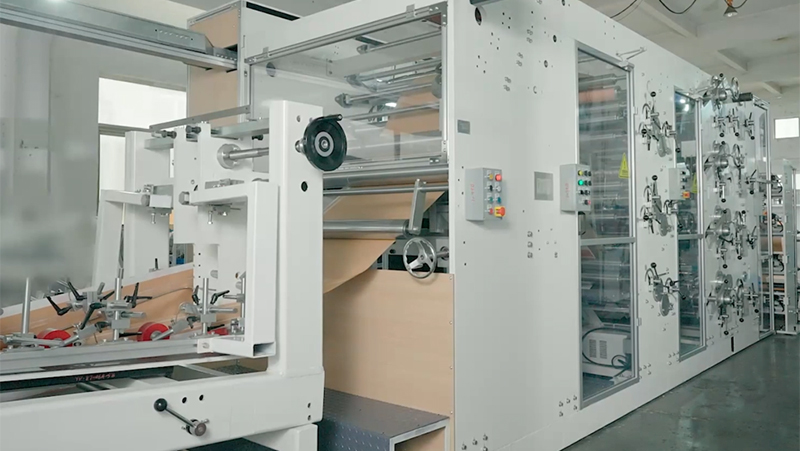Advancements in Automated Packaging Solutions: Exploring the Efficiency of Modern Automatic Labeling Paper Bag Machines
Release time:2025-05-15 Classification:Knowledge
The packaging industry has undergone significant technological evolution in recent decades, with automatic labeling paper bag machines emerging as a cornerstone innovation for manufacturers seeking precision, speed, and operational consistency. These sophisticated systems integrate multiple processes—from bag formation to label application—into a single streamlined workflow, addressing critical demands for scalability and quality control in production environments.

Technical Overview
Automatic labeling paper bag machines are engineered to handle diverse materials, including recycled paper, kraft paper, and laminated substrates, while maintaining precise dimensional accuracy. The core mechanism combines servo-driven motion control with advanced sensor technology to synchronize bag creation and labeling phases. Unlike semi-automated alternatives, these fully autonomous systems eliminate manual intervention, reducing human error and enhancing throughput rates to levels exceeding 2,000 units per hour in high-performance models.
Key Functional Components
- Integrated Labeling Module: Equipped with rotary or linear applicators, this subsystem ensures millimeter-perfect label placement regardless of bag size or shape. Optical sensors detect positioning marks to adjust application angles dynamically, accommodating variable print designs.
- Adaptive Feeding System: Multi-directional conveyors with tension control mechanisms stabilize paper rolls during unwinding, while programmable logic controllers (PLCs) monitor material thickness to prevent jams or misalignments.
- Thermal Transfer Printing: Onboard printing units support variable data labeling (e.g., barcodes, expiration dates) using resin-based ribbons, achieving smudge-resistant impressions compliant with ISO standards for retail and logistics.
Operational Advantages
- Precision Engineering: Laser-guided cutting systems produce bags with tolerances under ±0.3mm, critical for automated filling lines in food and pharmaceutical sectors.
- Energy Efficiency: Variable-frequency drives (VFDs) optimize power consumption during idle periods, reducing energy usage by up to 40% compared to conventional systems.
- Quick Changeover Capability: Modular tooling designs allow operators to switch between bag sizes within 15 minutes using pre-configured digital templates, minimizing downtime in mixed-SKU production runs.
Industry Applications
These machines have become indispensable in sectors requiring stringent labeling compliance. For instance, in agricultural packaging, they apply moisture-resistant labels to seed bags with UV-curable adhesives. Cosmetic manufacturers leverage their ability to handle metallic-finish labels on luxury paper pouches without compromising adhesive integrity. Additionally, e-commerce logistics providers utilize their high-speed operation to process custom-printed mailing bags with integrated tracking labels.
Technological Innovations
Recent iterations incorporate machine vision systems that perform real-time quality audits. High-resolution cameras inspect label orientation, print clarity, and adhesive coverage, automatically rejecting defective units. Some advanced models feature IoT connectivity for predictive maintenance, analyzing motor vibration patterns and bearing temperatures to schedule component replacements before failures occur.
Sustainability Integration
Automatic labeling paper bag machines align with circular economy principles through several design features:
- Compatibility with water-based adhesives and soy inks
- Scrap reduction algorithms optimizing paper roll utilization
- Energy recovery systems capturing waste heat from sealing units
Maintenance and Longevity
Constructed with hardened steel components and food-grade lubricants, these machines demonstrate MTBF (Mean Time Between Failures) ratings exceeding 10,000 hours. Automated lubrication systems and HEPA-filtered airflow in critical zones extend service intervals while maintaining hygiene standards in cleanroom environments.
Future Development Trends
Ongoing research focuses on enhancing AI-driven adaptive learning, enabling systems to self-adjust parameters based on material batch variations. Emerging prototypes trial laser labeling technologies to eliminate consumables like ink and ribbons, potentially revolutionizing eco-friendly packaging solutions.
In conclusion, automatic labeling paper bag machines represent a paradigm shift in industrial packaging, merging technical sophistication with environmental stewardship. As global demand for sustainable, intelligent packaging grows, these systems will continue to serve as vital enablers for manufacturers navigating the complexities of modern supply chains.






